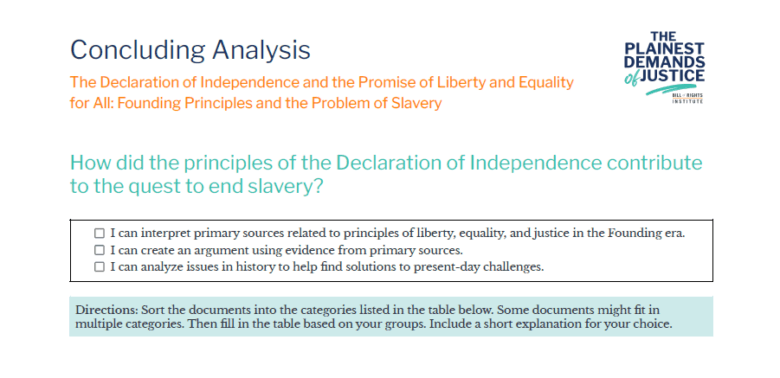Concluding Analysis: Promise of Liberty and Equality
How did the principles of the Declaration of Independence contribute to the quest to end slavery?
- I can interpret primary sources related to principles of liberty, equality, and justice in the Founding era.
- I can create an argument using evidence from primary sources.
- I can analyze issues in history to help find solutions to present-day challenges.
Directions: Sort the documents into the categories listed in the table below. Some documents might fit in multiple categories. Then fill in the table based on your groups. Include a short explanation for your choice.
| Document Title and Date | Laws and Policy | The Courts | “We the People” – individuals and groups |
|---|---|---|---|
| Elizabeth (Mumbet) Freeman portrait, 1811 | The courts provided the framework for Elizabeth Freeman to sue for her freedom | Elizabeth (Mumbet) Freeman used the courts to achieve her freedom | |
| The Declaration of Independence as approved by the Continental Congress, 1776 | |||
| Petition to the Massachusetts Legislature, January 13, 1777 | |||
| Constitution of Massachusetts, 1780 | |||
| Constitution of Kentucky, 1792 | |||
| Legal notes by Chief Justice William Cushing about the Quock Walker case, 1783 | |||
| The Northwest Ordinance, 1787 | |||
| The Southwest Ordinance, 1790 | |||
| Excerpts from the U.S. Constitution, ratified 1788 | |||
| Petition from the Pennsylvania Society for the Abolition of Slavery, 1790 |
- Could the United States have formed a union without ending slavery first? Explain your reasoning.
- Despite stating that all men are created equal in the Declaration of Independence, it took the United States 89 years and a bloody Civil War to end the practice. Discuss the consequences of waiting so long to end slavery. Consider the men and women who were enslaved during this time period.
- In what ways did laws and policies in the Founding era depart from or build on the principles of liberty, equality, and justice contained in the Declaration of Independence during the time period? The courts? Individuals and groups?
- Which group seemed most effective in advancing the faithful application of Founding principles to all people? Why?
- How were laws, courts, and individuals and groups’ words and actions complementary and how were they in conflict? In other words, did the courts and laws support each other, or did they contradict each other? Did individuals and groups work within the confines of current laws or policies or push back against them?
- How did the principles of the Declaration of Independence contribute to the quest to end slavery? Support your answer using evidence from the primary sources provided, as well as your own knowledge of U.S. history.
